Tidal Exchange



A principal reason people visit Elkhorn Slough is to enjoy the beauty and diversity of its natural surroundings. As part of the Pacific Flyway, and a Globally Important Bird area, the slough attracts birders from around the world. Thanks to the slough’s calm waters and abundance of marine life, kayakers return again and again to paddle its seven-mile length. More than 40,000 visitors wander the Reserve’s peaceful trails down to the slough’s edge, shaded by ancient oaks.
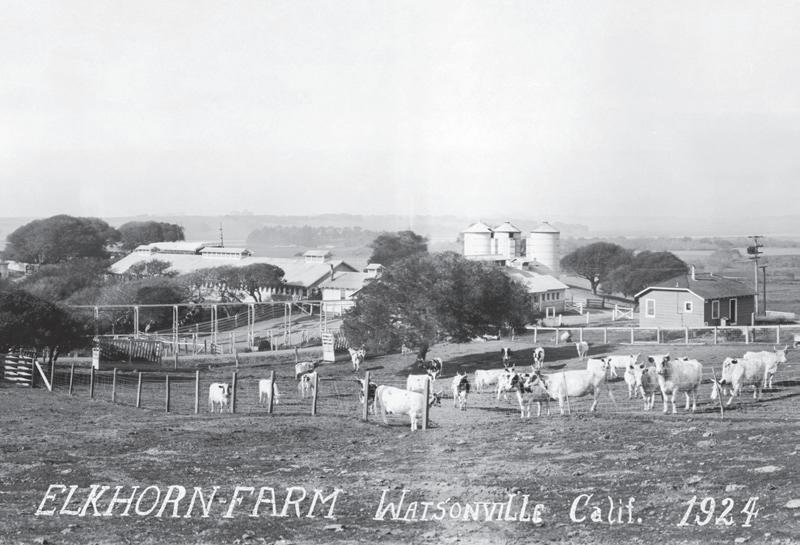
Yet this place wasn’t always a haven for wildlife and recreation. Decades ago, the Reserve consisted of derelict dairy buildings and abandoned pastures, with acres of wetlands diked and drained. Large areas of the slough’s uplands harbored wornout sandhill farms plagued with problems of erosion and runoff. It was a very different landscape, and it has taken many years and dedicated partners working together to conserve the Elkhorn Slough we know today.
A landmark event occurred 35 years ago when the Wildlife Conservation Board (acting as acquisitions arm for the California Department of Fish and Wildlife) purchased the old Elkhorn Dairy to establish the newly designated Elkhorn Slough National Estuarine Research Reserve.
The National Estuarine Research Reserve System (a network of 28 reserves protecting vital coastal and estuarine resources) is federally funded through the National Oceanic and Atmospheric Administration (NOAA), with local or state agencies responsible for the management of each Reserve.
At Elkhorn Slough, the California Department of Fish and Wildlife manages the Reserve. In 1982, the Reserve’s citizens advisory committee, working with the Reserve manager, formed the Elkhorn Slough Foundation (ESF) to develop research, education and volunteer programs on the new Reserve.
As the Foundation worked toward these ambitious goals, the community rallied to the call. Within a year, a group
Elkhorn Slough Foundation
Judith Connor
Anne Olsen
C. Michael Pinto
Robert Hartmann
Steven Webster
Ed Boutonnet
Terry Eckhardt
Steve Green
Sandy Hale
Kent Marshall
Anne Secker
Murry Schekman
Thomas Williams
Mary Wright
Mark Silberstein
Executive Director
The mission of the Elkhorn Slough Foundation is to conserve and restore Elkhorn Slough and its watershed.
We see Elkhorn Slough and its watershed protected forever— a working landscape, where people, farming, industry, and nature thrive together. As one of California’s last great coastal wetlands, Elkhorn Slough will remain a wellspring of life and a source of inspiration for generations to come Tidal Exchange
PO Box 267, Moss Landing California 95039
tel: (831) 728-5939
fax: (831) 728-7031
www.elkhornslough.org
Sandy Hale and Murry Schekman Join the ESF Board of Directors
We are pleased to welcome two new directors to the ESF board: Sandy Hale and Murry Schekman. Along with a passion for our coastal environment, Sandy Hale brings expertise in finance and strategic planning to the ESF board. Sandy was a member of the original management team of the newly formed U.S. Environmental Protection Agency, and subsequently co-founded and was president of a large international environmental and natural resource consulting firm. More recently, he served as Dean of the School of Business Administration at CSU Monterey Bay. Sandy has been active in local environmental groups as board chair of the nonprofit California Coastal Rural Development Corporation and of Point Lobos Foundation, and as a member of the Monterey Bay National Marine Sanctuary Advisory Council. He and his wife, Hope, are longstanding members of the Elkhorn Slough Foundation.

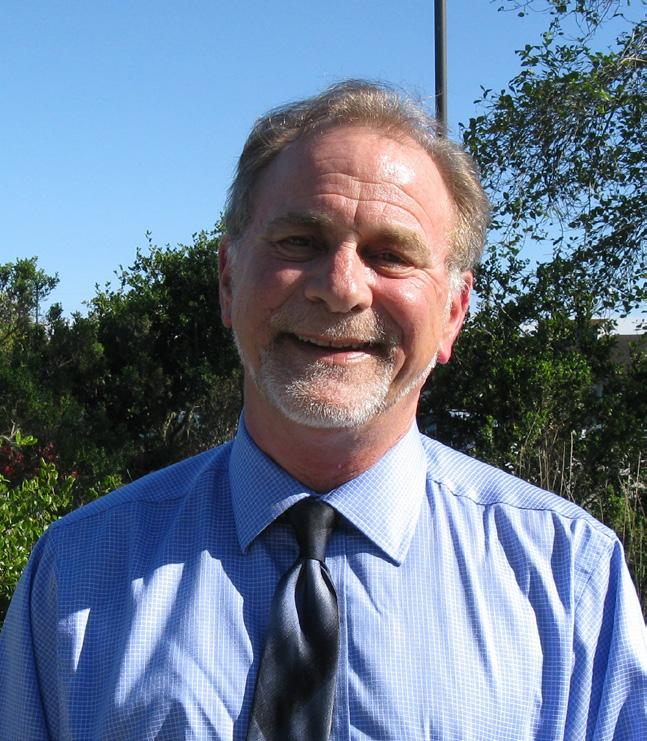
Murry Schekman is Assistant Superintendent of Secondary Education for the Pajaro Valley Unified School District. Earlier in his career, Murry served as Principal of six different schools including Everett Alvarez High School in Salinas and Watsonville High School. As we design outreach programs to inspire the next generation of conservationists, Murry will offer his experience, insight, and perspective. He and his wife, Delia, enjoy kayaking the slough and wandering the Reserve’s trails. n

Hugging the marshes of the Upper Elkhorn Slough, the Kirby Park Trail celebrates its 25th anniversary this year. Using the trail is free, as well as barrier-free — in fact, it’s the only wheelchairaccessible trail along the shoreline of the slough.
The trail began as the dream of Howard and Phoebe Hall, avid birders who loved watching the birds, wildlife, and natural beauty of the slough at Kirby Park. When illness confined Phoebe to her wheelchair, they continued to visit, with Howard frequently carrying Phoebe over the rough terrain.
Howard included the Elkhorn Slough Foundation in his estate plans and his generous bequest, along with funding from the Coastal Conservancy, sparked construction of the Kirby Park Trail. This special trail allowed Phoebe to continue birding at the slough when Howard was no longer there to carry her. The trail continues to help the community stay healthy and enjoying the outdoors. To watch a video about one man’s path to fitness, visit elkhornslough.org/connect and follow the link to our YouTube channel.


Kirby Park, operated by the Moss Landing Harbor District, also features a kayak launch, a wide variety of birds and wildlife, and scenic views of the landscape that defines Elkhorn Slough and its watershed. A stroll along the trail is a wonderful way to access the slough (and a great alternative on Mondays and Tuesdays, when the Reserve is closed). n
With the energy and enthusiasm of several hundred devoted volunteers, and a thriving partnership with California State Parks, ESF has planted approximately 15,000 native plants at Moss Landing State Beach since 2013, repairing coastal dune habitat at the doorstep of the slough. Volunteers also helped propagate the plants at the Reserve greenhouse.
“People really care about this place,” says Katie Pofahl, ESF Outreach Coordinator.
“When they’re planting these seedlings, you can see the connection become personal.”
“The trail is really special. It’s like being in the front row at a parade instead of watching from up above.”
Phoebe Hall

Native plants help stabilize the coastal dunes and minimize wind erosion, provide scenic access for visitors, reduce park maintenance costs, and protect critical habitat for wildlife — including endangered Western snowy plovers, which nest here.
“The planting days have been a huge success. The work of ESF, State Parks, and community volunteers has enabled us to improve the park for visitors and wildlife, while reducing maintenance costs.”
Steve Bachman
California State Parks
“Last year, researchers documented a pair of snowies nesting and hatching three chicks in dunes we helped restore,” Katie says. “It’s a great sign that our restoration work is making a real difference.”
To watch time-lapse video of the community dune restoration, visit elkhornslough.org/connect and link to our YouTube channel. n


continued from cover

of educators was developing curricula and programs for schools. Nearby Moss Landing Marine Laboratories expanded its long-established research programs at Elkhorn Slough to include the Reserve. The Nature Conservancy’s “Slough Volunteers”, established in 1983, became the genesis of the current volunteer program. In 1989, the California Wildlands Program provided funding and resources that allowed the Reserve to take on education and volunteer management, and ESF transferred these programs to the Reserve with continuing support and cooperation. This move freed the time and resources needed for the Foundation to become a land trust, actively acquiring and restoring key slough lands. Following a watershed-wide conservation plan developed in cooperation with the Reserve, the Department of Fish and Wildlife, The Nature Conservancy, and the California Coastal Conservancy, the Foundation has expanded the conservation footprint around the slough by thousands of acres.
Though today the Reserve features reminders of its history as a dairy (top), the original acquisition included almost none of the tidal areas of the slough. Until the early 1980s, several hundred acres consisted of diked marshes that were dry for a good part of the year (center). Over time, through purposeful restoration and the erosion of aging levees, these lands reverted to tidal marsh and mud flats (bottom).
“We learned how to build cages around baby oak trees .… In the future, whenever I pass this place, I will look up and say, ‘Wow! I helped grow these trees!’”
Early on a cool Saturday morning, more than a dozen students from North Monterey County High School are already hard at work on the Foundation’s Porter Ranch property, placing protective fencing around young coast live oaks planted to restore native woodlands. These students are the faces of the next generation of conservation — and they are the founding members of ESF’s Slough Stewards, a collaborative program with the high school’s “Go Green” club that offers students hands-on experience with conservation science and land stewardship. Slough Stewards learn in the classroom and work alongside professional researchers and land managers, contributing to habitat restoration, land stewardship,
Maria Perez, Student & Slough Steward North Monterey County High School
and wildlife monitoring projects that benefit the Elkhorn Slough watershed.
As the students gain exposure to careers in conservation science, they develop and share insights on how their actions can benefit the local environment and economy, by protecting native habitat and wildlife close to home. Whether they ultimately pursue careers in research, stewardship, or follow a different path entirely, the Slough Stewards are expanding their horizons and, at the same time, bringing conservation home. n
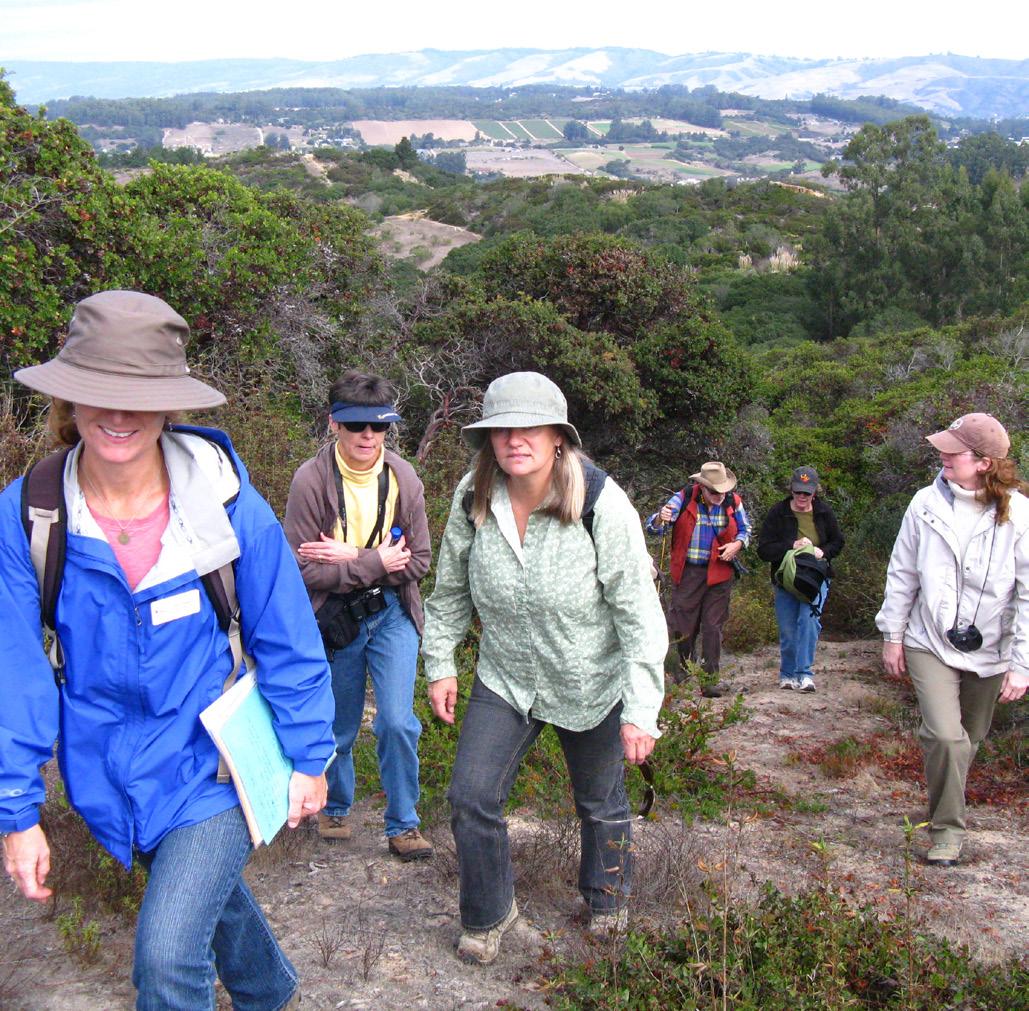
Initially charged with developing research, education, and volunteer programs on the new Reserve, today ESF is a land trust protecting almost 4,000 acres of watershed lands — from chaparral-crowned hills, to rolling coastal grasslands, to lush pickleweed marsh.
Today, the Reserve protects 1,700 acres, including more than five miles of hiking trails, a prize-winning visitor center, research facilities, and an education lab. The Foundation owns and stewards almost 4,000 additional acres, where it restores native habitat, creates wildlife corridors, models environmentally responsible organic farming, and inspires appreciation of the Elkhorn Slough and its watershed. It is because of these enduring partnerships that Elkhorn Slough exists as we know it today — an amazing place of beauty, wildlife, education, research, stewardship, and so much more. n
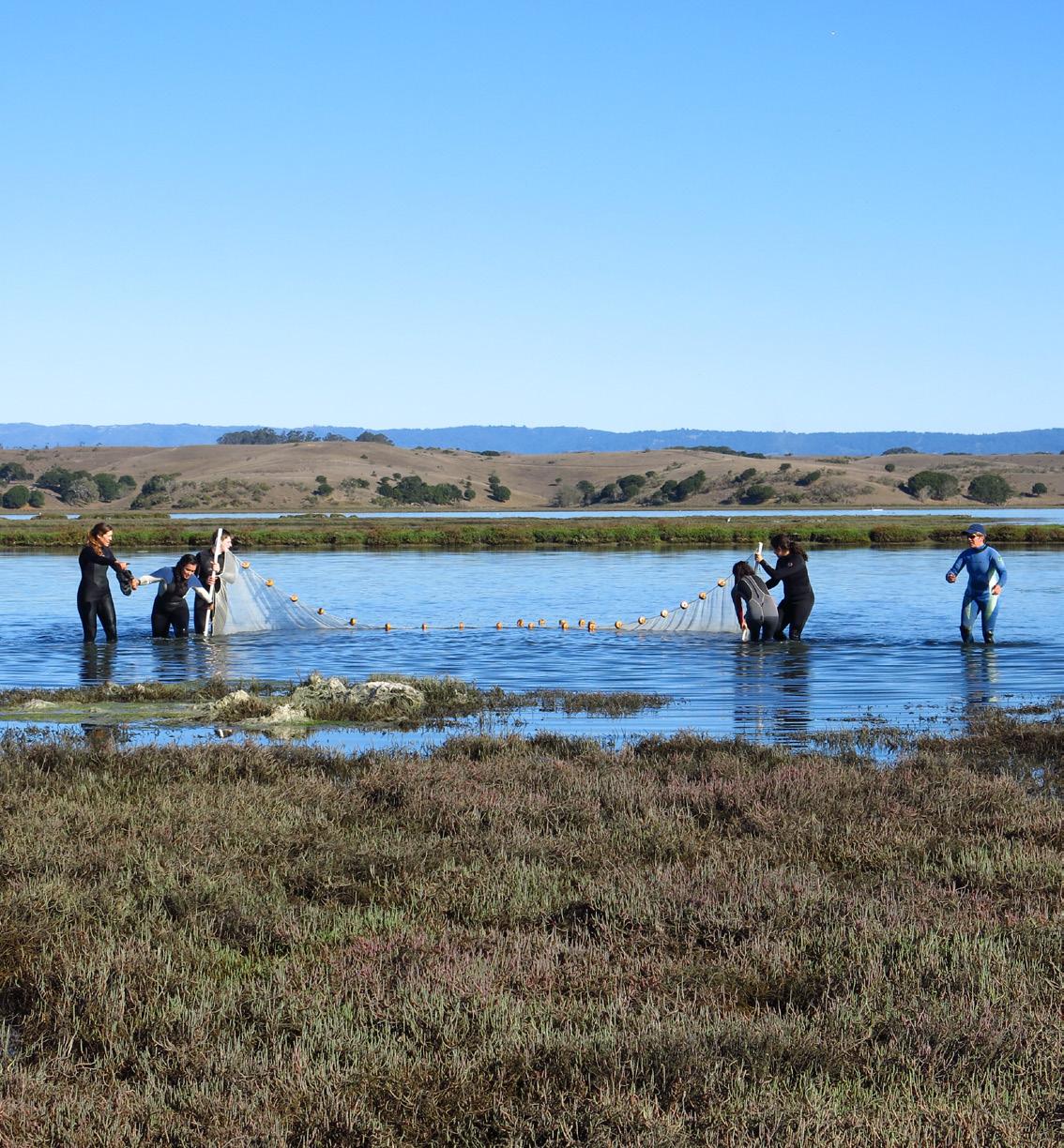
One of the keys to the success of slough conservation is the development and evolution of strong partnerships and collaborations between interested groups. Due to the partnership between the Elkhorn Slough National Estuarine Research Reserve, the National Oceanic and Atmospheric Administration, the California Department of Fish and Wildlife, and the Elkhorn Slough Foundation, we have been able to have a lasting impact and long list of accomplishments:
• The Department of Fish and Wildlife's Reserve education program has offered hands-on experiences and explored the wonders of the slough with more than 125,000 students.
• The Reserve research team has published dozens of peerreviewed scientific papers and informed the design and monitoring of extensive habitat restoration programs around the slough.
• Thousands of acres of wetland and upland habitat have been restored by the collective efforts of ESF and Reserve staff working with partners in the community.
• The Reserve and Foundation, along with Monterey County, have maintained the longest-running surface water quality monitoring program on the central coast. More than 25 years of data provide a powerful look at patterns and trends in water quality around the slough.
• Volunteers have contributed tens of thousands of hours toward the care and stewardship of slough lands and the education of students and visitors. Volunteers are the heart and soul of slough programs.
• Together the Reserve and Foundation conserve more than 5,500 acres, including 600 acres of farm and ranch land – keeping valuable land in production, while retiring properties that were overly steep or eroding into the slough.
• The acreage conserved by the Reserve and Foundation protects 12% of the oak woodland, 36% of wetlands, 11% of grasslands, 22% of rare chaparral, and 5% of farm and ranch lands in the Elkhorn Slough watershed.
• In addition to the value of habitat, our work has dramatically reduced groundwater pumping in a seriously over-drafted groundwater basin. The Elkhorn Slough Foundation alone has retired more than 650 acres of worn out sandhill farm lands that were major sources of erosion, sedimentation and polluted run-off into the slough. This amounts to about 2,000 acre-feet (more than 650 million gallons) of water left in the ground each year — a significant annual contribution to water conservation n
Each spring along Hall Road in the Elkhorn Slough watershed, a vibrant display of wildflowers blankets the hillsides of the Foundation’s 330-acre Porter Ranch property.
Many wildflowers native to central coast grasslands grow relatively low to the ground, and flourish best when surrounding grasses do not overshadow them. In the distant past, coastal prairie like this would have been trimmed seasonally by herds of mammals, including elk, giving the wildflowers time to bloom and go to seed before the grasses regained full height.


conditions, cattle are rotated through a series of pastures to graze. In addition to keeping grasses trimmed so that native wildflowers can flourish, grazing cattle fertilize the soil, reduce thatch, and encourage germination by working the seeds and soil with their hooves.
Understanding these ecological benefits — as well as the property’s history as a working ranch since the Spanish land grants — ESF Stewardship Director Kim Hayes, working with the cattle rancher, implemented a program of managed grazing at Porter Ranch. Each year, according to site-specific
In January, Governor Brown honored the Elkhorn Slough Foundation with California’s highest environmental honor — the Governor’s Environmental & Economic Leadership Award — for its ecosystem-based watershed stewardship focused on land acquisition, education, science and land restoration in order to successfully maintain one of California’s important wetland areas.
The Foundation is being honored for its achievements and collaborative work in protecting the rare habitat of the central coast, including: brokering 48 land transactions, directly protecting nearly 4,000 acres of land, restoring more than 2,000 acres of coastal habitats, and developing innovative research and education programs.
“Elkhorn Slough stands as a national model of publicprivate partnership in strategic science-based conservation, engaging a wide range of stakeholders to protect and improve an entire coastal watershed,” said Julie Packard, Executive Director of the Monterey Bay Aquarium.
The result is a working landscape that bursts with an astounding array of wildflowers, year after year, and provides needed habitat for grassland-dependent species, such as burrowing owls, savannah sparrows, and badgers. n
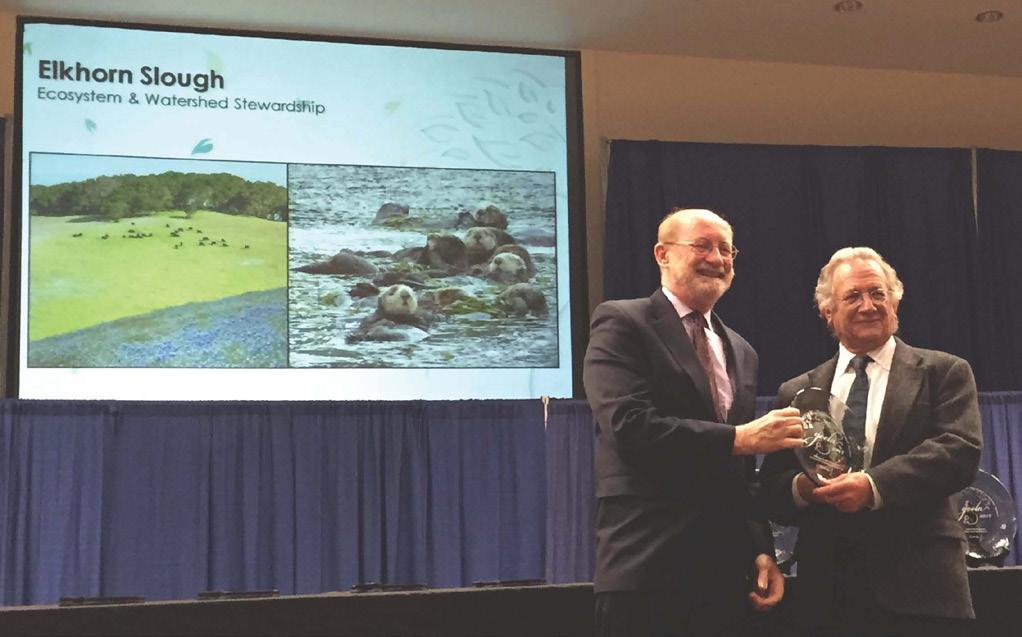
On the national level, ESF earned accreditation from the Land Trust Accreditation Commission (LTAC), an independent program of the Land Trust Alliance. ESF is one of only 280 land trusts (of about 1,800 nationwide)accredited since Fall 2008. Accredited land trusts meet national standards for excellence, uphold the public trust and ensure that conservation efforts are permanent. The LTAC accreditation seal is a mark of distinction in land conservation.
“Accreditation provides the public with an assurance that land trusts meet high standards for quality and that the results of their conservation work are permanent,” says LTAC Executive Director Tammara Van Ryn n
year ending June 30, 2014
Caring for nearly 4,000 acres of land, engaging more than 500 individuals to restore Moss Landing State Beach, and supporting education, volunteer, research, and stewardship programs at the Elkhorn Slough Reserve takes many resources and dedicated individuals. We are able to leverage the generosity of our individual donors into millions of dollars of grant funding. And together we advance the mission to conserve and restore Elkhorn Slough and its watershed. We are grateful.
We provide here a summary of our fiscal standing as of the end of our most recent fiscal year. We hope this illustrates that your commitment to us is well placed. With your support, we are protecting a magical place that has inspired — and will continue to inspire — generations. Thank you!












Mark Silberstein, ESF Executive Director
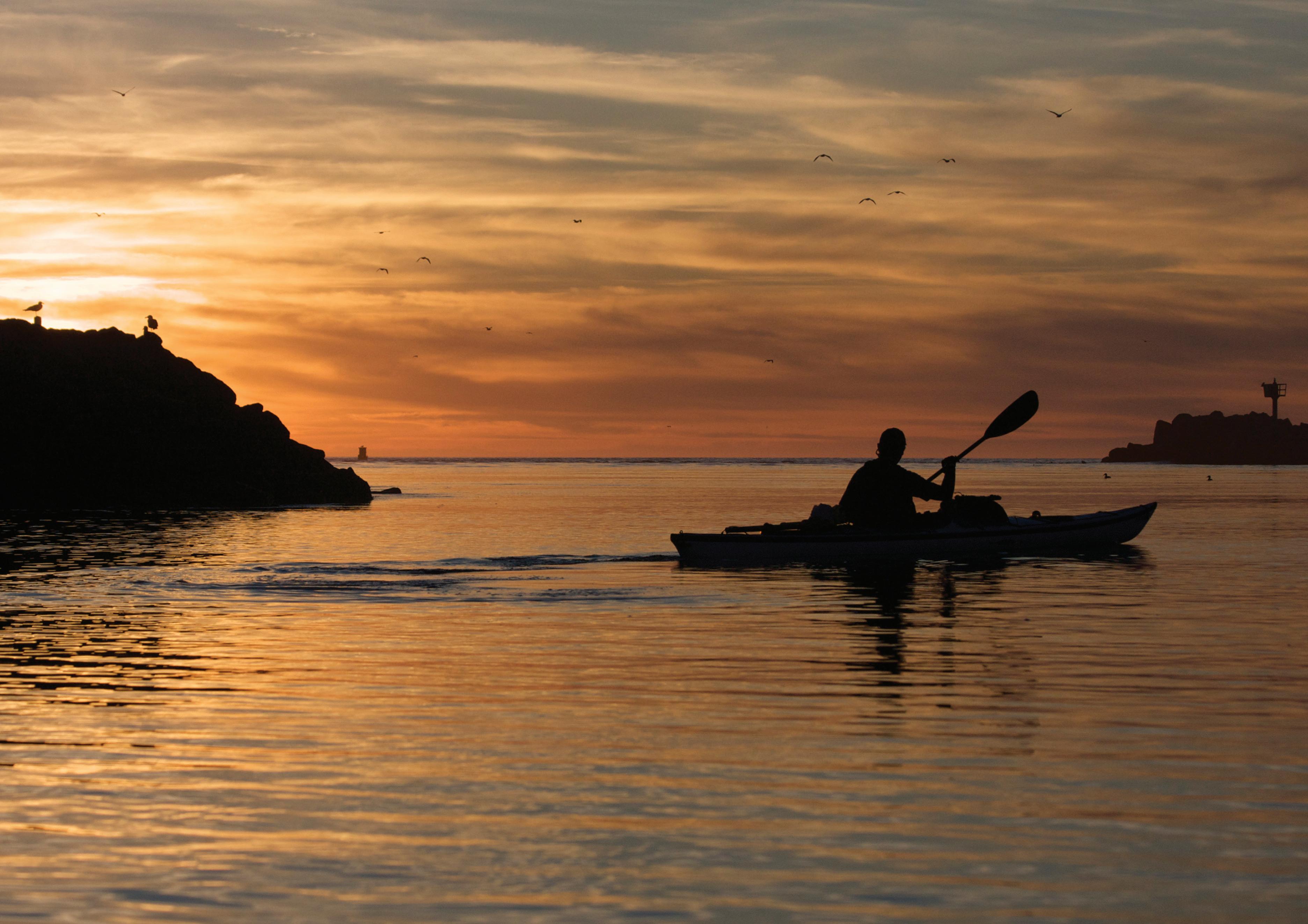
This year marks the 35th anniversary of the establishment of the Elkhorn Slough National Estuarine Research Reserve. While the Reserve was nominated and designated in 1979, it was in 1980 that active land acquisition began and the California Department of Fish and Wildlife (then known as the Department of Fish and Game) hired a manager to develop the Reserve.
The past 35 years have seen great strides in the conservation of Elkhorn Slough. I am always inspired when I think about our deepening understanding of, and the positive changes that have occurred in, this landscape.
In 1972 the National Oceanic and Atmospheric Administration (NOAA) was charged with developing and managing a plan to “preserve, protect, develop, and where possible, to restore or enhance the resources of the nation’s coastal zone.” One task was set up to identify key estuaries in coastal states and to work with state and local governments to conserve and restore the sites and establish them as “outdoor laboratories and field classrooms.” Elkhorn Slough was the first National Estuarine Research Reserve in California, and the California Department of Fish and Wildlife (CDFW) was designated the management agency.
A partnership between the NOAA and CDFW was formed, and the Foundation was established to complete
the unique partnership. Thirty-five years ago this place was a worn out dairy farm. Today, the Reserve is the hub of activity for the slough and includes 1,700 acres with more than five miles of hiking trails, an award-winning Visitor Center, a Research and Education center and outstanding programs. This campus is owned and managed by the Department of Fish and Wildlife. In addition, a dozen people work on research, monitoring, training, stewardship, and education programs funded by NOAA, overseen by CDFW and administered by the Elkhorn Slough Foundation. The Foundation has an office on the Reserve and employs a team to manage the Land Trust function and to keep the non-profit operations running smoothly.
As you drift over the tideflats in a kayak at high tide, with pulsating jellies just below the surface, flocks of terns and pelicans diving for fish, hundreds of harbor seals and sea lions, and the densest concentration of sea otters on the coast, witness the amazing return on investment that the slough has yielded.
We thank you — our members and supporters — and the hundreds of volunteers and community members that are all critical parts of this vital partnership. You have “kept the faith” with Elkhorn Slough and contributed to its longterm care and sustainability n
P.O. Box 267
Moss Landing, CA 95039
The Elkhorn Slough Reserve is open Wednesday through Sunday, 9 am to 5 pm. Join us for docent-led tours every Saturday and Sunday at �0 am and � pm.
SAVE THE DATES: Join us for our upcoming events. For more information, call 83�.728.5939 or visit www.elkhornslough.org.
• Saturday, April 11: ESF Wildflower Walk
• Sunday, April 12: ESF Birding Safari (aboard Elkhorn Slough Safari, with birding guide Rick Fournier)
• Saturday, April 18: Coastal Cleanup Day
• Saturday, May 16: Spring Birding Walk (with expert birder Rick Fournier as our guide)
• Saturday, May 30: Kayaking with ESF
• Saturday, June 20: Poetry Walk & Workshop (Led by award-winning poet Patrice Vecchione)


